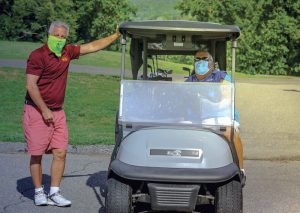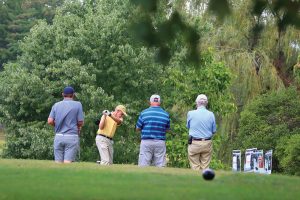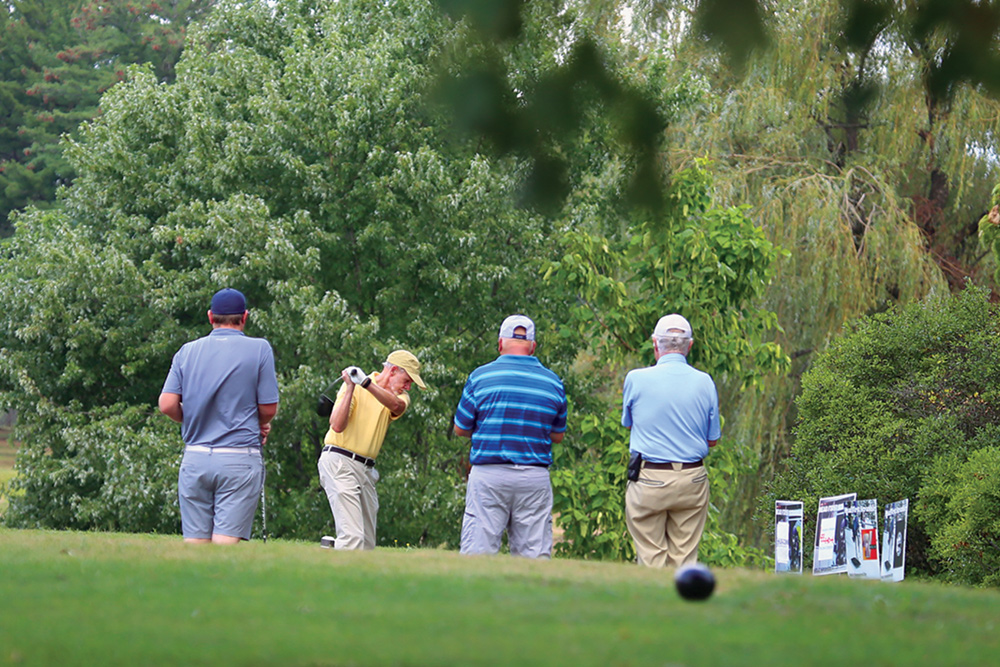 Thanks to golf, 2020 in Connecticut has not been quite as isolating as we had feared it would be when the COVID-19 pandemic hit with full force in late winter.
Thanks to golf, 2020 in Connecticut has not been quite as isolating as we had feared it would be when the COVID-19 pandemic hit with full force in late winter.
In fact, most golf courses report that play is up considerably this year, and pros are seeing new golfers by the dozens taking up the game. All of this is a good sign for a sport that endured an unwelcome flattening and dipping of the curve in popularity in recent years, for a variety of reasons. Now, people seem more than pleased to get out and spend four or five hours in the company of friends, when before they would bemoan how long it took to play 18 holes.
My, how attitudes change about life’s opportunities when a crisis rears its ugly head!
Governor Ned Lamont on March 24 ordered all non-essential businesses, including golf courses, to close when the pandemic hit, in an effort to limit the spread of coronavirus. But only 36 hours later, after lobbying by the Connecticut State Golf Association and individual courses, Lamont and the Department of Economic and Community Development (DECD) allowed courses to continue operation, as long as they adhered to strict guidelines meant to eliminate any kind of contact and encourage social distancing.
At Hop Meadow Country Club in Simsbury, the course has been packed since it opened. “Play has been busy and active all year long,” reports Joe Cordani, Jr., director of golf. “We are up approximately 40 percent in rounds this season. The COVID-19 pandemic has in this way been a blessing and golf has been a terrific way to get outdoors and spend time with your family and friends. It has been like a perfect oasis to be able to have members play here during the pandemic.”
Jason Loomis, head golf professional at Great River Golf Club in Milford, says “play has been through the roof!” He also reported rounds to be up 40 percent this year over last. “So many people are just happy to have something to do,” he says.
Harwinton’s Fairview Farm Golf Course opened early this year, as other Connecticut courses did, but had to close for a while when the pandemic hit. Since the course reopened in late March, it has been flooded with golfers. “Play has been significantly more than usual,” says head golf professional Bob Sparks. “I have been here 20 years and it’s the most amount of play I have ever seen. Tee times have been sunup to sundown.”
Loomis says his club, in compliance with state and CDC guidelines, adopted rules and regulations out of the norm. “These changed almost weekly, between the state and CDC. We started out not allowing carts, then we moved to single rider, now you can ride together if you wear a mask. We also started out not being able to touch the flagstick and we used foam inserts to prevent the ball from going in the hole. Now we are back to normal flags and cups. We have always been very liberal about cleaning our carts; we just add a disinfectant to the cleaning procedure.”
Clubs in late summer were still not allowed to have water stations on the course or ball washers. They could also not have tournaments or events larger than 100 people.
Cordani says guest play at Hop Meadow, a private club, was restricted until June. Then, it became Monday through Thursday only. “After July 4th, we got back to normal guest policy. Our bag room was closed until mid-May and carts are restricted to one rider per cart, unless it’s a spouse or child.”
 “We opened up for play on March 8, the earliest it has ever opened, and were excited for a great season,” says Jeffrey Beyer, head golf professional at South Windsor’s Topstone Golf Course. “Once the COVID-19 pandemic began, we all felt that we would have to close the golf course for the foreseeable future, with no idea on when we would open again. When it was announced that Connecticut golf courses could remain open with specific guidelines, we quickly began preparing for the restrictions.”
“We opened up for play on March 8, the earliest it has ever opened, and were excited for a great season,” says Jeffrey Beyer, head golf professional at South Windsor’s Topstone Golf Course. “Once the COVID-19 pandemic began, we all felt that we would have to close the golf course for the foreseeable future, with no idea on when we would open again. When it was announced that Connecticut golf courses could remain open with specific guidelines, we quickly began preparing for the restrictions.”
Topstone’s clubhouse was closed and management installed self-swipe credit card readers at the outside entrance to the golf shop; set up a cleaning schedule of all high-touch areas around the staging area and clubhouse; and made sure its entire golf cart fleet was cleaned before going out again when turned around for new customers. The golf carts were also cleaned again at the end of the day. Says Beyer, “In addition, we took in all ball washers, water coolers, scorecards, and pencils from the golf course. Players were also restricted to riding one player per golf cart.”
Over time, according to Beyer, restrictions began to loosen. “Now, the clubhouses and the golf shop are open, scorecards and pencils are being given out, and players can ride two to a golf cart. We still clean and disinfect all high-touch areas plus keep up the strict golf cart cleaning schedule. We keep using the self-swipe credit card readers because they are safer and speed up the check-in time.”
Beyer has seen “a lot of new golfers this year” most initially from out of state because courses beyond Connecticut were closed. But, to local course owners’ and managers’ delight, many out-of-staters keep coming back on a weekly basis. There have also been many more Connecticut residents coming to play Topstone for the first time who have become “regulars.” Most golfers express gratitude to Beyer that the course remained open and say that they feel safe while playing.
Watertown’s Crestbrook Park Golf Course allowed play beginning in late March but started the year with the pro shop building closed, and taking only online and phone payments. “We were fortunate to open the building and get back to normal check-ins,” says head golf professional Jan Wivestad. “Masks to enter our building and social distancing seem to be the most significant change from normal operations. We can now touch flags but we started with no touching flags, no rakes around bunkers, and only one person per cart, which made it hard on business with no tournaments. We are catching up with things. We had an event here that was safe and went off without a hitch. I’m happy to say that our new normal really isn’t that bad after all. Play in general has been significantly busier as people seem to have more free time, and golf is in a good place moving forward.”
Blue Fox Run Golf Course in Avon also saw a lot of out of state play, mainly from Massachusetts, early on. For several months, course restrictions included no rakes near bunkers, ball lifts in holes, asking golfers to stay six feet apart, and one rider per cart. “Now, rakes are okay, scorecards are okay, and you can now pull the pins on the greens,” says Barry Wilson, general manager, “as well as allowing two people in a cart with masks.”
Wilson says if courses were not allowed to open, they would have suffered economic damage that some might not be able to recover from, as is the case with other businesses. “We would still have had to pay our superintendent and grounds crew, as well as pay for chemicals to maintain course conditions.” All that with no income.
Wilson has also seen a number of new players, “lots of first-timers, plenty of college kids. I think golf is the safest sport to play. Most people are 200 yards away when on the courses. Hopefully we can keep the new golfers.”
‘Peter Joyce, general manager and COO at Wampanoag County Club in West Hartford, says opening the course allowed membership a “mental escape” from the day-to-day challenges that COVID-19 presents. “Play has increased significantly. With no school or after-school recreation, along with college being dismissed earlier than expected, golf became one of the only options for families. Wampanoag became a haven for families to enjoy their club in a safe environment.”
As with other courses, Sparks says he and management at Fairview Farm Golf Course didn’t know what they would be faced with when they originally had to close. “We had an early start (in early March) and it looked like it was going to be a great year. COVID-19 hit, and we didn’t know what was going to happen.”
He believes golf has proven to provide some normalcy and an outlet for many during these “crazy” times. “Customers were very thankful, understanding, and appreciative to be able to play golf. Of course, parties and outings have suffered. But we have had some outings with no food and tee time starts that have been successful.”
Sparks says the guidelines that were put in place initially were very challenging, with payments having to be taken over the phone. “We purchased a gazebo to take payments outside and alleviate the phone calls because we just couldn’t keep up. Single golf carts were challenging since we just don’t have enough carts and it was much more traffic and wear on the golf course.”
Fairview Farm is known as a learning ground for youngsters. Sparks was pleased that camps and lessons have kept him and others busy. “Many sports are not able to be played, but golf is the only sport outdoors where you don’t share any type of equipment. My U.S. Kids Junior Tour has had record numbers and is not slowing down during the fall.”
Former PGA Tour pro Bobby Gage, head golf professional at Winsted’s Green Woods Country Club, was disappointed that his club’s junior camps were cancelled this season but he plans to get them going again next year. “New golfers have been prevalent, and the game seems to be growing in that respect.”
One aspect of golf courses that has suffered has been food and beverage operations. The chow and drinks have been mostly takeout, which cuts into proceeds from liquor and food sales because, as we know, golfers usually enjoy hanging out at the “19th hole” after a round and talking over the day with a cold one nearby.
Great River Golf Club shut its impressive indoors bar and dining area at the start of the season but later offered pre-made sandwiches and bottled beverages outdoors. Says Loomis, “Once the state allowed us to do outside dining, we were very fortunate because we have a large patio.”
Hop Meadow Country Club, says Cordani, is adhering to all DECD guidelines as it pertains to food and beverage. “We started the year doing takeout only, which was well received by our members.”
Beyer says Topstone Restaurant has kept busy by offering food delivery to golfers on the course and began a “robust” to-go Family Meal Deal. “As restaurant restrictions eased, we set up outside dining on our patio and in other outside areas that we have never used before. Both have become so popular that we will continue to use them in the future.”
Joyce and his staff had to “think outside of the traditional country club box” to give options to members. “We are offering to–go, both à la carte and family-style options, and themed to-go nights as well. When we were able to open our large patio, it became a sell-out nightly. Providing a safe environment for membership and staff was paramount,” he adds. “The hours of training and guidance to ensure members and staff felt comfortable has paid off. We have been very fortunate that the weather has been so dry this summer, which allowed us to enjoy many nights outside.”
Opening a new business in the midst of the COVID-19 pandemic has, of course, been a challenge. Such was the case for Ron Beck, PGA director of golf coaching at Northeast Performance Institute in Portland. “Mostly, it was just getting our building built. Programming changed to only include individual coaching and very small groups.”
Beck has noticed the golf market is “booming” with new players and “lapsed” players getting back into the game. “It’s no wonder. People are craving entertainment and outdoor activities with social distancing. What could be better than golf?”
Beck opened his business July 20 and has been busy. Clientele has run the gamut, he says, from advanced competitive players to rank beginners who show up with their newly purchased box sets.
Says Beck, “In the long run, golf will be viewed as one of the few industries that is better off because of COVID-19. We just have to keep all these new and returning players interested and engaged.”
Photography By Mark William Paul







More Stories
Over 50, Underestimated: The Grandfluencers Redefining Age on Social Media
Building Resilient Businesses: Strategies for Success
Summer Means Convertibles